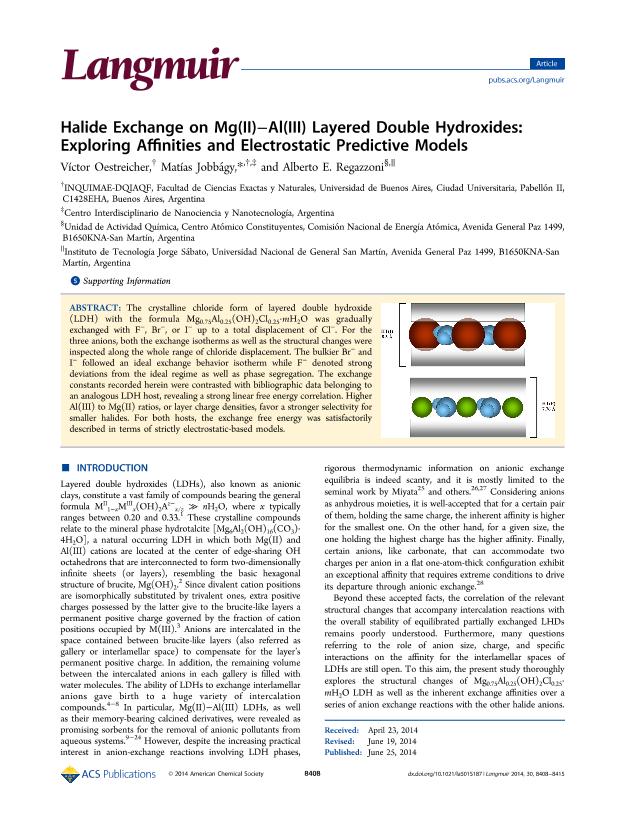Mostrar el registro sencillo del ítem
dc.contributor.author
Oestreicher, Víctor Santiago Jesús

dc.contributor.author
Jobbagy, Matias

dc.contributor.author
Regazzoni, Alberto Ernesto

dc.date.available
2018-02-02T19:12:44Z
dc.date.issued
2014-06
dc.identifier.citation
Oestreicher, Víctor Santiago Jesús; Jobbagy, Matias; Regazzoni, Alberto Ernesto; Halide Exchange on Mg(II)–Al(III) Layered Double Hydroxides: Exploring Affinities and Electrostatic Predictive Models; American Chemical Society; Langmuir; 30; 28; 6-2014; 8408-8415
dc.identifier.issn
0743-7463
dc.identifier.uri
http://hdl.handle.net/11336/35533
dc.description.abstract
The crystalline chloride form of layered double hydroxide (LDH) with the formula Mg0.75Al0.25(OH)2Cl0.25·mH2O was gradually exchanged with F–, Br–, or I– up to a total displacement of Cl–. For the three anions, both the exchange isotherms as well as the structural changes were inspected along the whole range of chloride displacement. The bulkier Br– and I– followed an ideal exchange behavior isotherm while F– denoted strong deviations from the ideal regime as well as phase segregation. The exchange constants recorded herein were contrasted with bibliographic data belonging to an analogous LDH host, revealing a strong linear free energy correlation. Higher Al(III) to Mg(II) ratios, or layer charge densities, favor a stronger selectivity for smaller halides. For both hosts, the exchange free energy was satisfactorily described in terms of strictly electrostatic-based models.
dc.format
application/pdf
dc.language.iso
eng
dc.publisher
American Chemical Society

dc.rights
info:eu-repo/semantics/openAccess
dc.rights.uri
https://creativecommons.org/licenses/by-nc-sa/2.5/ar/
dc.subject
Hydrotalcite
dc.subject
Anion-Exchange
dc.subject
Equilibrium Constants
dc.subject.classification
Otras Ciencias Químicas

dc.subject.classification
Ciencias Químicas

dc.subject.classification
CIENCIAS NATURALES Y EXACTAS

dc.title
Halide Exchange on Mg(II)–Al(III) Layered Double Hydroxides: Exploring Affinities and Electrostatic Predictive Models
dc.type
info:eu-repo/semantics/article
dc.type
info:ar-repo/semantics/artículo
dc.type
info:eu-repo/semantics/publishedVersion
dc.date.updated
2018-02-02T13:29:04Z
dc.journal.volume
30
dc.journal.number
28
dc.journal.pagination
8408-8415
dc.journal.pais
Estados Unidos

dc.journal.ciudad
Washington
dc.description.fil
Fil: Oestreicher, Víctor Santiago Jesús. Consejo Nacional de Investigaciones Científicas y Técnicas. Oficina de Coordinación Administrativa Ciudad Universitaria. Instituto de Química, Física de los Materiales, Medioambiente y Energía. Universidad de Buenos Aires. Facultad de Ciencias Exactas y Naturales. Instituto de Química, Física de los Materiales, Medioambiente y Energía; Argentina
dc.description.fil
Fil: Jobbagy, Matias. Consejo Nacional de Investigaciones Científicas y Técnicas. Oficina de Coordinación Administrativa Ciudad Universitaria. Instituto de Química, Física de los Materiales, Medioambiente y Energía. Universidad de Buenos Aires. Facultad de Ciencias Exactas y Naturales. Instituto de Química, Física de los Materiales, Medioambiente y Energía; Argentina. Centro Interdisciplinario de Nanociencia y Nanotecnología; Argentina
dc.description.fil
Fil: Regazzoni, Alberto Ernesto. Comisión Nacional de Energía Atómica; Argentina. Universidad Nacional de San Martín; Argentina
dc.journal.title
Langmuir

dc.relation.alternativeid
info:eu-repo/semantics/altIdentifier/doi/http://dx.doi.org/10.1021/la5015187
dc.relation.alternativeid
info:eu-repo/semantics/altIdentifier/url/http://pubs.acs.org/doi/10.1021/la5015187
Archivos asociados
